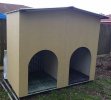Bridgebob
Active Member
Yes to that. The height is easy to adjust.You should use a smaller wattage bulb and use a thermometer to set the height correctly so that the temperature under the heat lamp is not too hot and not too cool.
I have it really distant - 2+ feet.
She loves it and she can move away from the heat.
I turn it off usually at night.
It's a food warming lamp.

